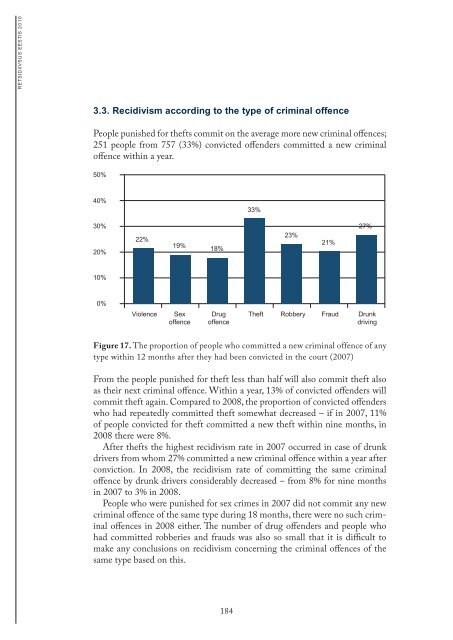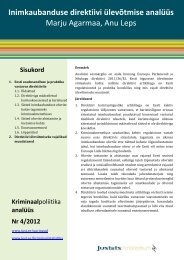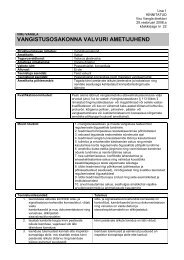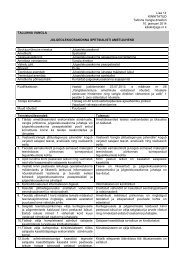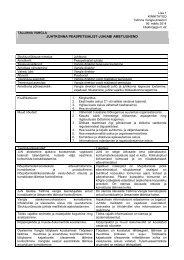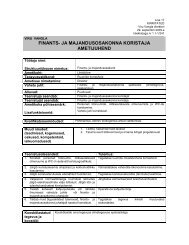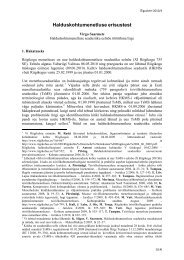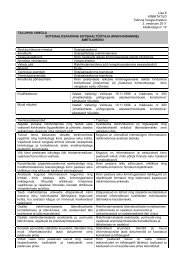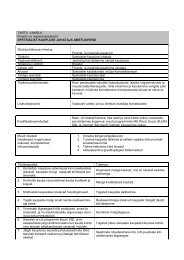11. Retsidiivsus Eestis - Justiitsministeerium
11. Retsidiivsus Eestis - Justiitsministeerium
11. Retsidiivsus Eestis - Justiitsministeerium
You also want an ePaper? Increase the reach of your titles
YUMPU automatically turns print PDFs into web optimized ePapers that Google loves.
RETSIDIIVSUS EESTIS 2010<br />
3. RECIDIVISM OF CONVICTED OFFENDERS<br />
RETSIDIIVSUS EESTIS 2010<br />
3.3. Recidivism according to the type of criminal offence<br />
People punished for thefts commit on the average more new criminal offences;<br />
251 people from 757 (33%) convicted offenders committed a new criminal<br />
offence within a year.<br />
3.4. Recidivism with respect to other factors<br />
In 2007, the overall recidivism rate for convicted offenders was 24%. Within<br />
a year, the judgement of conviction entered into force with respect to 6019<br />
people (except punishments with actual imprisonment), from those people<br />
practically every fourth (1438) committed a new criminal offence within a<br />
year.<br />
There were 92% of men and 8% of women among convicted offenders;<br />
within a year, a new criminal offence was committed by 25% of men and 16%<br />
of women.<br />
Figure 17. The proportion of people who committed a new criminal offence of any<br />
type within 12 months after they had been convicted in the court (2007)<br />
From the people punished for theft less than half will also commit theft also<br />
as their next criminal offence. Within a year, 13% of convicted offenders will<br />
commit theft again. Compared to 2008, the proportion of convicted offenders<br />
who had repeatedly committed theft somewhat decreased – if in 2007, 11%<br />
of people convicted for theft committed a new theft within nine months, in<br />
2008 there were 8%.<br />
After thefts the highest recidivism rate in 2007 occurred in case of drunk<br />
drivers from whom 27% committed a new criminal offence within a year after<br />
conviction. In 2008, the recidivism rate of committing the same criminal<br />
offence by drunk drivers considerably decreased – from 8% for nine months<br />
in 2007 to 3% in 2008.<br />
People who were punished for sex crimes in 2007 did not commit any new<br />
criminal offence of the same type during 18 months, there were no such criminal<br />
offences in 2008 either. The number of drug offenders and people who<br />
had committed robberies and frauds was also so small that it is difficult to<br />
make any conclusions on recidivism concerning the criminal offences of the<br />
same type based on this.<br />
Figure 18. The proportion of people who committed a new criminal offence<br />
within 12 months after a judgement of conviction had been rendered with respect<br />
to them by age groups<br />
By age groups the highest number of people committing a new criminal<br />
offence was among convicted offenders up to 18 years old (36%). Probably<br />
in case of this group we are dealing with young people in whose case the<br />
convicted offence was not the first encounter with criminal proceedings and<br />
who have committed more serious criminal offences as well. The fact that every<br />
third person from these young people commits already within a year after<br />
conviction the next criminal offence also refers to the fact that the direction<br />
of a person’s behaviour with procedural instruments has not been successful.<br />
By age groups the least criminal offences within a year after conviction were<br />
committed by 54 year old and older people, their recidivism rate was 13%.<br />
Just like in case of findings made with respect to terminated proceedings,<br />
the thing which is different with respect to recidivism calculated on the basis<br />
184<br />
185


